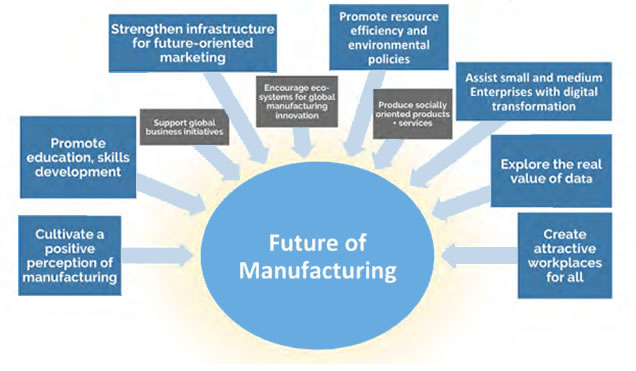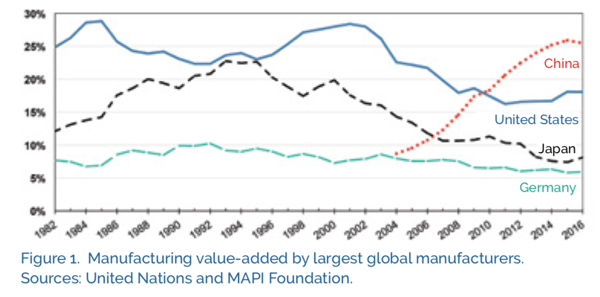
America's manufacturing sector and its importance to the country's economic well-being and national security cannot be overstated. While manufacturing makes up 8.5% of U.S employment and 11.7% of U.S. GDP (gross domestic product), our country’s manufacturers drive 35% of productivity growth, 60% of exports, and 70% of private-sector research and development (R&D). This is of big importance to not only to you and me — and the nation — but the global supply chain as well.
This data and more are included in the latest Manufacturing USA Annual Report, available free of charge from the U.S. Department of Commerce's National Institute of Standards and Technology (NIST) Advanced Manufacturing National Program Office. Some of the highlights…
We all know that dramatic changes occurred in U.S. manufacturing during the early part of the 21st Century. While manufacturing employment fell by 5.6 million jobs from December 2000 to December 2010 — during the peak of the Great Recession — it has only recovered 20% of this loss.
Let’s go back further — to the 20th century — where advances in manufacturing, including the latest and most useful equipment and new workforce talent, led to much of America’s global economic dominance in manufacturing throughout the 1900s.
Innovation for the future is tightly linked to advances in new manufacturing technologies, such as Internet of Things (IoT), additive manufacturing and industrial robotics. Lower skilled jobs and those relying on outdated technology are disappearing. Only through advanced manufacturing and new technology (including business management software) is productivity enhanced and new high-paying jobs created. Education and workforce development are paramount to keeping — and growing — these jobs and the manufacturing sector.
The U.S. leads the world in innovation and inventions, yet many U.S. research discoveries are translated into manufacturing capabilities and cutting-edge products in other countries.

Perhaps one of the most exciting trends for the nation’s manufacturers is the ability to build products that can transform the ways Americans work and live.
Example: Through the NextFlex manufacturing institute (America’s Flexible Hybrid Electronics Manufacturing Institute, funded primarily by the Department of Defense) a new “smart” bandage for non-healing wounds integrates oxygen delivery in combination with medical sensing systems in a low-cost, flexible dressing.
In addition, bioenergy and bioproducts are emerging worldwide as new and rapidly growing sectors of the highly productive agricultural and forest industries. Manufacturing bio-based products (e.g. biofuels, industrial chemical intermediates, performance polymers, and finished higher value products) represent a significant opportunity for the U.S. How?
Supporting expansion of a bio-economy has the potential to:
While agricultural and forest sectors are essential for ensuring sustainable, reliable, and accessible production of bio-based products, there are even greater benefits:
In all, there are fourteen (14) Manufacturing USA institutes, sponsored by the Departments of Commerce, Defense, and Energy. Examples that piqued my interest, based on some of the companies we work with and talk to every day at xTuple are:
The RAPID manufacturing institute leads a national effort focused on the research, development, and implementation of high impact technologies and hardware equipment solutions that enable advances in the process industries — notably, chemicals, oil and gas, pulp, and paper. Process industries are facing fierce global competition and require innovation and investment, yet progress has remained stagnant in these industries due to factors such as prohibitive capital costs, the high complexity of intensified modular systems, and insufficient software, design tools and data.
The IACMI manufacturing institute is committed to increasing domestic production capacity and manufacturing jobs across the U.S. composites industry. IACMI partners private industry with academic researchers and workforce development leaders to validate composites manufacturing materials and processes in vehicle, wind turbine, and compressed gas storage production that enables private industry to advance manufacturing techniques. Validation of these techniques and materials allow U.S.-based businesses to integrate the techniques into production, allowing the U.S. manufacturing industry to lead global competitiveness now and in the future.
A major goal of the PowerAmerica institute is to facilitate the industry’s switch from silicon-based power electronics to silicon carbide power electronics, which are more efficient. SiC power devices can be used to more efficiently regulate electrical power — losing 30% less power than traditional silicon devices. However, the cost of developing a manufacturing technology for SiC devices presents a significant barrier to companies, particularly small ones.
A team at N.C. State University has developed a manufacturing process, known as PRESiCE, which companies can use to create their own SiC devices. The team’s goal is to drive the price of silicon carbide devices from five times that of silicon devices down to 1.5 times. The process is exclusively available at the X-FAB Texas SiC foundry, a former silicon foundry that was upgraded to a silicon carbide foundry with the help of PowerAmerica funding. By helping companies avoid the steep price of developing their own manufacturing process, PRESiCE aims to enable more silicon carbide manufacturing, thus driving down the overall cost of silicon carbide as more companies produce SiC products and lowering their barrier to market entry.
U.S. manufacturing accounts for nearly 25% of the nation’s total annual energy use., and the REMADE institute is working to improve U.S. manufacturing competitive- ness by partnering with industry to develop advanced manufacturing technologies that incorporate energy-reduction and sustainability principles. REMADE aims to drive down the energy and cost required to recover, reuse, remanufacture and recycle four classes of materials: metals, fibers, polymers, and electronic waste.
CESMII focuses on developing and deploying integrated advanced sensors, controls, platforms, and high-performance computational models to help U.S. manufacturers benefit from smart manufacturing, making them more competitive globally. With smart manufacturing, manufacturers optimize their business, technology, infrastructure, and workforce practices using engineered systems that integrate operational technologies and information technologies.
“Smart manufacturing makes it possible for companies to re- duce their energy use and save money on their energy bills by optimizing their manufacturing processes. In fact, increased investments in Smart Manufacturing could save American manufacturers $15 billion in annual electricity cost savings by 2035,’ says Ethan Rogers, Industry Program Director, American Council for an Energy-Efficient Economy.
The Commerce Department’s NIST is the only research laboratory in the U.S. government specifically focused on enhancing industrial competitiveness, with a robust research portfolio concentrated on the technical challenges associated with advanced manufacturing. In addition, the NIST Manufacturing Extension Partnership (MEP), comprised of 51 centers located in all 50 states and Puerto Rico, is a critical resource to engage small and mid- size manufacturers to develop new products, expand into global markets, and adopt new technologies, such as those in development at the Manufacturing USA institutes.
NIST also serves as headquarters for the interagency Advanced Manufacturing National Program Office.
Originally published October 10, 2018 (check back for updates). Read the full Manufacturing USA Report.
Contact
xTuple
A CAI Software Company
24 Albion Rd, Suite 230
Lincoln, RI 02865
+1-757-461-3022
About
"xTuple" (verb) — to grow; to increase exponentially. Our mission is to help manufacturing and inventory-centric companies use management software and best practices to grow their business profitably.